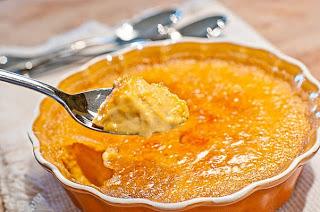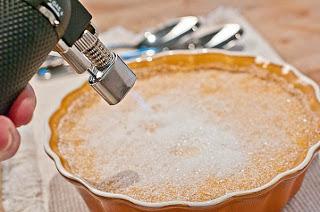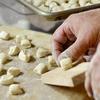Starting with fresh, high quality ingredients is crucial if you want perfect custard. Using the wrong ingredients or trying to rush each step will leave you with a watery, grainy dessert. You really do need to use heavy cream for this dish. While some recipes call for milk or half and half, these custards tend to be too soft and runny when cooked. Recipes that pair milk with extra egg yolks become rubbery and have a consistency more like flan. Double cream is the best choice, but it is not required. Egg yolks are the other key ingredient to create the perfect custard texture. You will need the yolks of five eggs for four servings; the recipe can be doubled or tripled. Look for fresh eggs and separate the yolks gently to avoid breaking them.* The final touch is a single, real vanilla bean. Vanilla extracts can`t provide the perfect flavor of a whole bean.
Once your ingredients are gathered, it is time to create your custard. You will need four ceramic ramekins and a large baking dish that is at least two inches deep and will sit inside the baking dish. This will become your bain marie (the French term for “water bath”), which is filled with hot water. This ensures the custard bakes slowly and evenly to maintain the proper texture and prevents the custard from curdling. The humidity from the steam that rises as the water heats helps keep the top of the custard from drying out and forming a crust.
 1 ½ cups heavy cream
1 ½ cups heavy cream1 ½ teaspoon cinnamon, freshly ground
¼ teaspoon allspice, ground
½ teaspoon ginger, freshly grated
¾ teaspoon nutmeg, freshly grated
5 egg yolks
½ teaspoon vanilla extract
Pinch of salt
6 tablespoons pumpkin puree
1/3 cup granulated sugar
1 tablespoon firmly-packed, light brown sugar
Plus 4 teaspoons granulated sugar
Begin by preheating an oven to 300°F. Bring a pot of water to a boil and keep hot in preparation for the bain marie.
Pour the cream into a small saucepan and whisk in the cinnamon, allspice, ginger and nutmeg. Scald the cream by set over medium-low heat and mixture until bubbles form around the edges of the pan and steam begins to rise from the surface, about 3 minutes. Stir the cream mixture regularly to avoid any scorching. Take the pan off the heat and give it 15 minutes to cool. Adding the milk to the egg yolks before they are cooled may cook the yolks too fast. The vanilla bean should be removed at this point. (If you freeze it, you can use it for future batches of crème brûlée!)
In a large bowl, whisk together the egg yolks, vanilla, salt, pumpkin puree, the 1/3 cup granulated sugar and the brown sugar until smooth and blended. Slowly pour in the cream mixture, stirring until blended. Pour the mixture through a fine-mesh sieve set over a bowl to remove any pumpkin fibers or larger bits of ginger and spices. Divide the mixture among four 8-oz. ramekins and place in a large baking pan. Add the boiling water to fill the pan halfway up the sides of the ramekins. Cover the pan loosely with aluminum foil and bake until the custards are just set, about 45 minutes. The custards should wiggle some, but not slosh. The custards will continue to firm up as they cool.
Remove the ramekins from the water and transfer them to a wire rack and let cool to room temperature. Cover with plastic wrap and refrigerate for at least 2 hours (up to 3 days).
 The crisp, brown sugar crust of a crème brûlée is what sets it apart from plain custards. Create the perfect crust by giving the ramekins an hour to warm up after refrigeration. Sprinkle about a teaspoon of sugar over the custards. Use a hand torch to carefully brown the sugar evenly. Move the flame continuously in small circles over the surface until the sugar melts and lightly browns; maintain a steady pace to avoid burnt or blackened spots. Once you achieve a crisp layer of sugar, serve immediately. The caramel crust will not last indefinitely; the moisture from the custard will eventually dissolve the sugar.
The crisp, brown sugar crust of a crème brûlée is what sets it apart from plain custards. Create the perfect crust by giving the ramekins an hour to warm up after refrigeration. Sprinkle about a teaspoon of sugar over the custards. Use a hand torch to carefully brown the sugar evenly. Move the flame continuously in small circles over the surface until the sugar melts and lightly browns; maintain a steady pace to avoid burnt or blackened spots. Once you achieve a crisp layer of sugar, serve immediately. The caramel crust will not last indefinitely; the moisture from the custard will eventually dissolve the sugar.* Remember to reserve the egg whites (albumen) for other recipes such as meringue cookies, angel food cake, white cakes, or meringue for pies. Egg whites can be frozen until you are ready to use them. Raw egg whites do not suffer from freezing. When separating eggs, have an ice cube tray at the ready. Pour each egg white into a compartment of the tray. This will work for small to large eggs. Place the ice cube tray in the freezer and freeze the egg whites. When completely frozen, pop the egg whites out and transfer them to a zip-top freezer bag and return them to the freezer. Whenever you need one, just thaw as many cubes, representing one egg white each, as needed in the refrigerator and use. Egg whites will deliver full volume if they are at room temperature. So, once the egg white is completely thawed in the fridge, let it come to room temperature before whipping.

